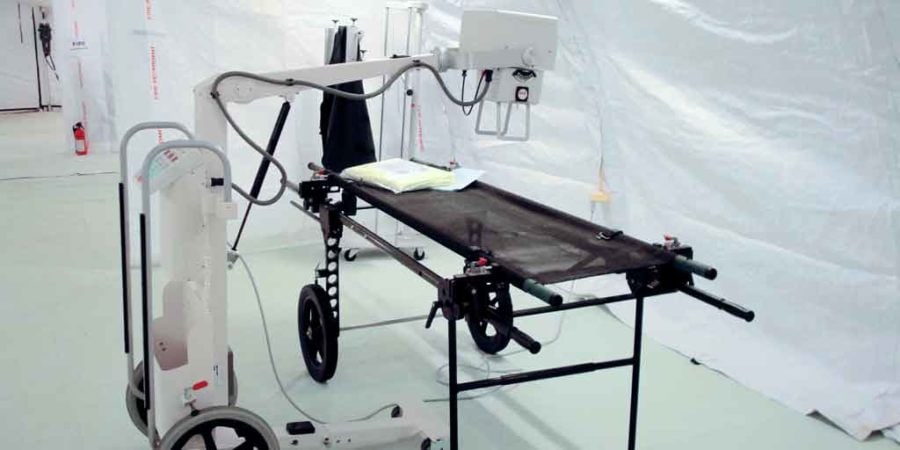Setting Up a Trauma Center
Over recent years, the U.S. has seen a surge in trauma centers opening up as hospitals expand their offerings to treat critically injured patients while also increasing their bottom line. At the same time, dangerous remote work operations and emergency response teams are realizing the importance of having trauma centers on hand to reduce permanent disablement and death from serious injuries.
But while the benefits of trauma centers may be obvious, the path to setting one up is less straightforward. Read on for trauma center basics, categorization levels, setup steps, and other important considerations.
This guide is for informational purposes only. If planning a trauma center, we recommend consulting your municipality’s or state’s governing agencies and resources for requirements and guidelines.
What Is Physical Trauma?
Physical trauma is defined as a serious bodily injury and is broken up into two main categories:
- Penetrating trauma: When an object pierces the body or skin, typically leading to an open wound
- Blunt force trauma: When a force or object strikes the body, potentially leading to broken bones, deep cuts, or concussions
Common causes of physical trauma include falls, motor vehicle crashes, burns, assaults, and gunshot wounds. Physical trauma can also be caused by surgery, which is sometimes referred to as a controlled injury.
What Is a Trauma Center?
A trauma center is a facility that provides resources and specialized medical services to patients with traumatic — and oftentimes life-threatening and disabling — injuries. This treatment is proven to reduce the chances of permanent disability and death for the injured patients.
The main difference between a regular hospital and a trauma center is the latter’s requirement for a team of health care providers trained in specialty care to be available 24/7. These providers must have expertise in treating traumatic injuries and often include nurses, radiologists, cardiac surgeons, orthopedic surgeons, neurosurgeons, and trauma surgeons. Trauma centers often require specialty resources to be available 24/7 as well, such as a pharmacy, blood bank, diagnostic testing, laboratory testing, an operating room, and a trauma resuscitation area within the emergency department.
While trauma centers are often located within hospitals, their services are purely supplementary — they are not meant to replace the emergency department or other traditional hospital services.
Trauma Center Levels
In the United States, trauma centers are categorized into specific levels via two processes: designation and verification. These levels set national standards for trauma care and are based on the types and quantities of resources available in a trauma center, as well as the number of patients admitted annually.
The designation process takes place first and occurs at the state or local level, where the unique criteria used to categorize trauma centers are identified. As such, the requirements to meet each trauma center level vary from one state to the next.
The American College of Surgeons (ACS) then carries out the verification process to verify that the resources listed in Resources for Optimal Care of the Injured Patient (including commitment, policies, resources, readiness, performance improvement, and patient care) are present. Designed to evaluate and optimize trauma care, this process is voluntary, and its findings expire after three years.
While trauma center categories vary by state, below are common criteria for trauma center levels designated by state and municipalities and verified by the ACS. Categorization for adult and pediatric facilities is unique, so facilities commonly achieve different designations for each group. For instance, a trauma center may be a level II adult facility but a level III pediatric facility.
Level I Trauma Centers
A level I trauma center is a tertiary care facility that serves a central role in the trauma system and is a holistic regional resource. It should be able to provide comprehensive care for all aspects of injury, starting with prevention and ending with rehabilitation.
Requirements for level I trauma centers often include:
- A minimum annual volume of severely injured patients
- A substance abuse patient intervention and screening program
- Research and training efforts to pursue trauma care innovations
- A comprehensive quality assessment program
- Continuing education for members of the trauma team
- Provision of public education and prevention leadership to nearby communities
- Referrals for nearby communities
- Round-the-clock in-house coverage by general surgeons
- Specialty care available promptly, including critical care, pediatric care, oral and maxillofacial, plastic surgery, internal medicine, radiology, emergency medicine, anesthesiology, neurosurgery, and orthopedic surgery
Level II Trauma Centers
Level II trauma centers should be capable of initiating definitive care for all injured patients.
Requirements for level II trauma centers often include:
- A comprehensive quality assessment program
- Continuing education and trauma prevention programs for trauma care team members
- Ability to refer tertiary care needs (such as microvascular surgery, hemodialysis, and cardiac surgery) to a level I trauma center
- Immediate round-the-clock coverage by general surgeons
- Specialty care available for critical care, radiology, emergency medicine, anesthesiology, neurosurgery, and orthopedic surgery
Level III Trauma Centers
Trauma centers that have demonstrated a capability to provide emergency care, intensive care, stabilization of injured patients, surgery, resuscitation, and prompt assessment generally qualify for level III categorization.
Requirements for level III trauma centers often include:
- An active outreach program and prevention efforts for referring communities
- Continuing education for trauma team members or for allied health and nursing personnel
- Transfer agreements in place with level I and II trauma centers for patients who require more comprehensive care
- A comprehensive quality assessment program
- Immediate round-the-clock coverage by emergency medicine physicians
- Prompt availability of anesthesiologists and general surgeons
Level IV Trauma Centers
Level IV trauma centers provide diagnostic, stabilization, and evaluation capabilities for injured patients. Trauma centers must demonstrate the ability to provide patients with advanced trauma life support (ATLS) before transferring them to a higher-level facility in order to qualify for level IV categorization.
Requirements for level IV trauma centers often include:
- An active outreach program and prevention efforts for referring communities
- A comprehensive quality assessment program
- Transfer agreements in place with higher-level trauma centers for patients who require more comprehensive care
- Ability to provide critical care services and surgery if available
- 24-hour laboratory coverage
- Ability to implement ATLS protocols with basic emergency department facilities
- Physicians and trauma nurse(s) available upon patient arrival
Level V Trauma Centers
Level V trauma centers provide diagnostic, evaluation, and stabilization capabilities for patients and then prepare to transfer them to higher-level care facilities.
Requirements for level V trauma centers often include:
- Transfer agreements in place with level I, II, and III trauma centers for patients who require more comprehensive care
- Ability to provide critical care services and surgery if available
- Protocols for after-hours activation is the facility is not open 24/7
- Physicians and trauma nurse(s) available upon patient arrival
- Ability to implement ATLS protocols with basic emergency department facilities
Steps to Set Up a Trauma Center
Successfully setting up a trauma center so that it achieves accreditation and is verified by the ACS is no simple task. Richard Buchler, director of Trauma Ready, explains six steps that are crucial to making a trauma center both functional and profitable:
- Understand the requirements: If you’ve read up to this point, you should already know the common requirements that are set by your municipality or state and verified by the ACS. Be sure to consult local resources to learn about the specific requirements in your area.
- Consider finances: While many hospitals assume that a trauma center will be more of a financial burden than a financial asset, this isn’t always the case. Depending on your hospital’s payer mix, a trauma center can easily add to your bottom line both immediately and long-term with downstream revenue. To make this happen, work with the physicians to ensure adequate documentation for reimbursement. Proper reimbursement will also require correct coding, as the trauma center should receive additional reimbursement for every minute that a trauma surgeon spends with the patient post-stabilization.
- Set up a trauma system: The whole hospital ecosystem needs to buy into the trauma program for it to be successful. Everyone across all phases of care — from prehospital and emergency department care to operating room procedures, subspecialist involvement, and follow-up — needs to understand and be involved in the system. Quality and regulatory compliance should be built in from the very beginning.
- Prepare for capacity issues: Capacity is a common challenge for trauma centers: patient volumes can fluctuate significantly and thus are difficult to predict. Careful planning and a unique, scalable model for staffing, equipment, and space will be necessary. While emergency department and intensive care unit (ICU) staff can be trained and volunteer to be part of the trauma center team for when demand surges, coming up with additional beds and operating rooms without monopolizing the hospital’s resources may be more challenging.
- Prepare the rest of the hospital: The entire hospital will be affected by the new trauma center and should be prepared for potential changes. Imaging, radiology, neurology, and orthopedics may be particularly impacted if the trauma center quickly becomes busy.
- Educate the community: A trauma center is a great benefit to and resource for the community. Reach out to community members to highlight the positive impact that the trauma center will have and educate on trauma prevention.
Mobile Field Hospitals for Trauma Centers
For Hospitals Lacking Capacity
Richard Buchler of Trauma Ready included preparing for capacity issues as one of his six crucial steps for setting up a successful trauma center. Greg Bishop, president of trauma consultancy firm Bishop + Associates, echoes Buchler’s concerns: “Your facility issues are key. You need enough ICU rooms and hospital beds, a number of operating rooms,” he told Chicago Business. “More precisely for most hospitals is to make sure you have a very strong trauma resuscitation room in the emergency department.”
For hospitals that simply don’t have the facility capacity, setting up a trauma center may not seem like a viable option — but they shouldn’t write off the possibility altogether.
Mobile field hospitals, which hospitals have long relied on to accommodate medical surge, can also be an effective solution for setting up a trauma center when the primary facilities lack space. These structures can be set up on the hospital grounds to provide easy access between the hospital and trauma center without encroaching upon the hospital’s other facilities.
Because mobile field hospitals are often durable enough for long-term use but also portable and quick to install, they’re equally ideal for permanent trauma centers and temporary additional space when trauma center demand surges (as it is likely to do).
[Related: Guide to Creating Space for Medical Surge]
For Remote Locations and Emergency Response
While trauma centers are generally located within or near hospitals and are part of the larger hospital system, the need for trauma centers isn’t limited to residential areas alone. For instance, remote work camps that are inherently dangerous may benefit from having a trauma center on the premises to treat injured workers. The same goes for any remote operations that have a high potential for traumatic injury (such as combat support hospitals).
Likewise, while traumatic injuries may occur somewhat regularly in residential communities due to more or less common occurrences (such as motor vehicle accidents), health care and emergency response organizations may also want to be prepared to respond to mass casualty incidents with quickly deployable trauma centers. Natural disasters, violent conflicts, plane crashes, and other large-scale emergencies may all warrant quick trauma center deployment.
The highly portable nature and efficient setup of mobile field hospitals make them ideal solutions for both of these needs.
[Related: Equipping Modern Field Hospitals for Effective Disaster Response]
Mobile Field Hospitals From BLU-MED
Looking for a mobile field hospital to add a trauma center to your hospital, remote location, or emergency preparedness plan? Deployable field hospitals and medical shelters from BLU-MED Response Systems® (BLU-MED) are unmatched in terms of durability, portability, and ease of use.
BLU-MED’s medical shelters can be set up in as little as 10 minutes and have the following benefits:
- Fully integrated HVAC, lighting, and UL-tested electrical facilities
- Ability to withstand snow loads of up to 20 pounds per square foot and winds of up to 100 mph
- A temperature- and humidity-controlled interior — even in extreme climates
Additionally, mobile field hospitals from BLU-MED are scalable to accommodate as many beds as your facility requires. Customizable medical equipment and supply packages are available to equip your trauma center with whatever’s necessary to achieve accreditation or a specific trauma center “level,” such as laboratory or X-ray equipment.
For more information on how a mobile field hospital from BLU-MED can help fulfill your trauma center needs, please fill out the above contact form, visit our Contact Us page, or email inforeq@blu-med.com.


